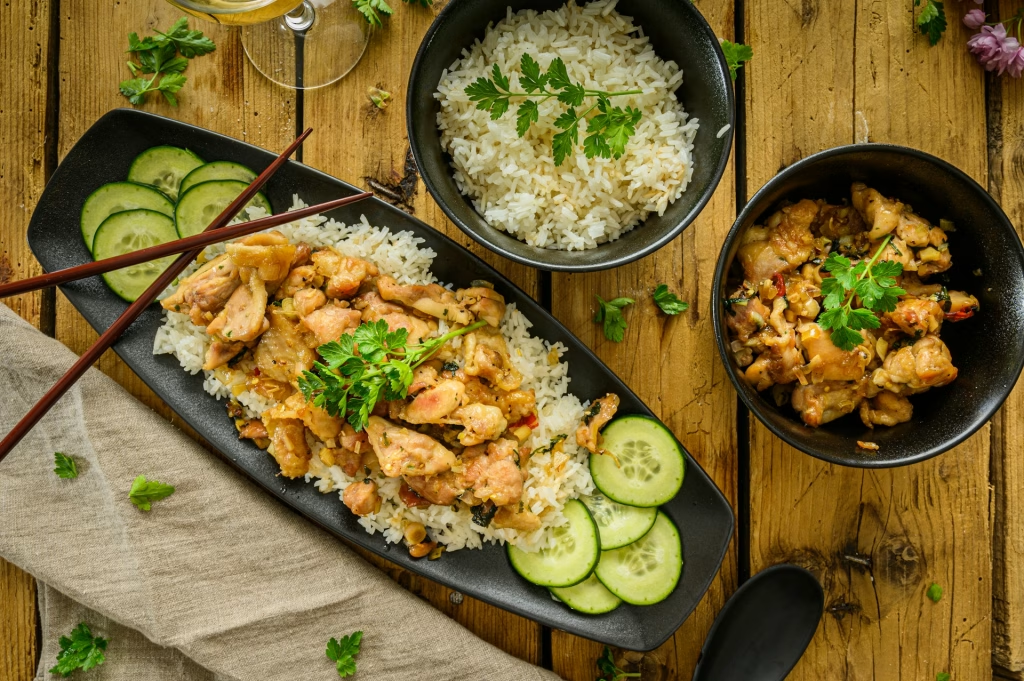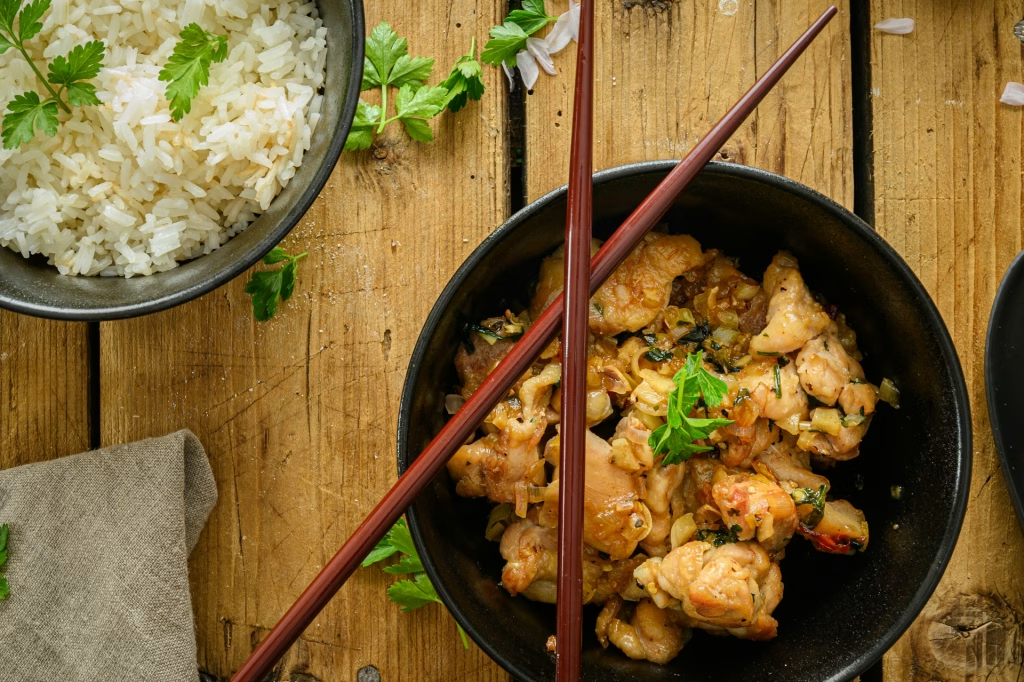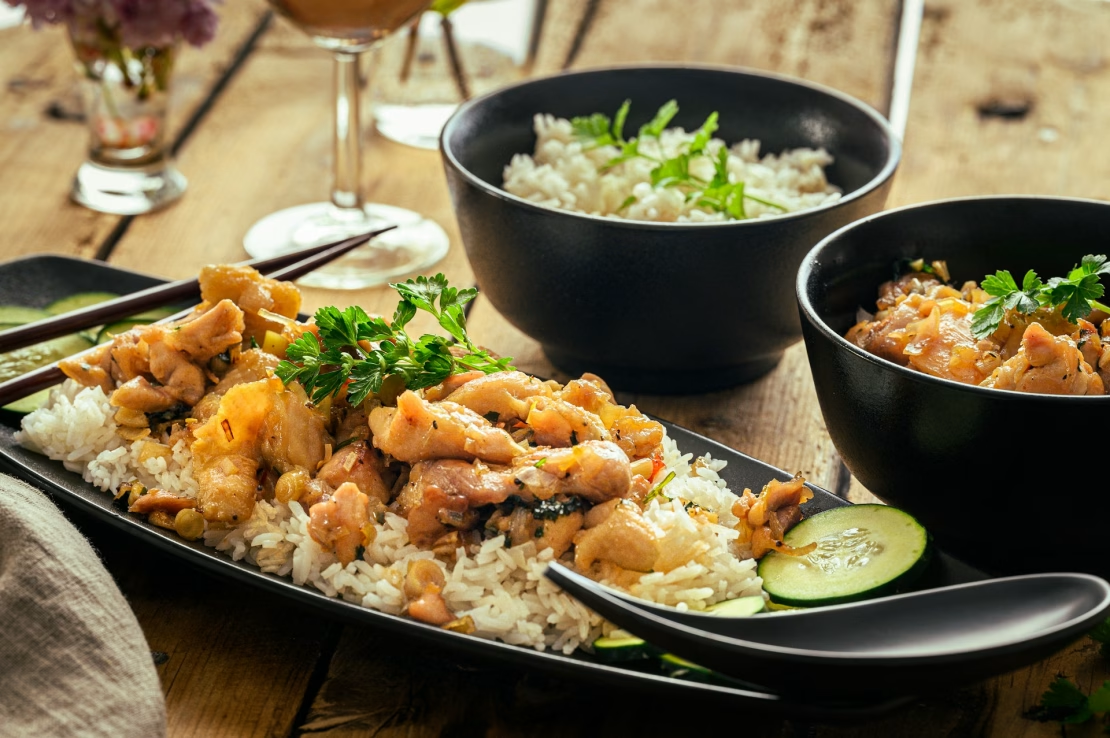Vietnamese Lemongrass Chicken (Gà Xào Sả) is a deliciously aromatic and flavorful dish that’s beloved in Vietnam and across the globe.
The combination of tender chicken, fragrant lemongrass, and a tangy marinade makes this dish an irresistible treat.
It’s light, fresh, and perfect for pairing with steamed rice or noodles. In this guide, we’ll show you how to make Vietnamese Lemongrass Chicken at home, including step-by-step instructions, tips, and serving ideas.
Table of Contents
Ingredients
- 500 grams (1.1 lbs) chicken thighs or breast, boneless and skinless, cut into bite-sized pieces
- 3 stalks of fresh lemongrass, finely minced (or 2 tablespoons of lemongrass paste)
- 2 cloves garlic, minced
- 2 shallots, minced
- 2 tablespoons fish sauce
- 1 tablespoon soy sauce
- 1 tablespoon sugar (preferably palm sugar)
- 1 tablespoon vegetable oil (for cooking)
- 1 tablespoon lime juice
- 1 teaspoon ground black pepper
- 1/2 teaspoon chili flakes or 1 fresh red chili (optional, for heat)
- Fresh cilantro or mint, chopped, for garnish
Serves
This recipe serves 4 people as part of a meal, with each serving consisting of a portion of the lemongrass chicken.
Step-by-Step Instructions
Step 1: Prepare the Marinade
- Make the Marinade: In a large bowl, combine the minced lemongrass, minced garlic, minced shallots, fish sauce, soy sauce, sugar, lime juice, black pepper, and chili flakes (if using). Stir well until the sugar has dissolved, and all ingredients are fully mixed.
- Marinate the Chicken: Add the chicken pieces to the marinade and toss to coat the chicken evenly. Cover the bowl and let it marinate for at least 30 minutes, though marinating for 1-2 hours will enhance the flavor.
Step 2: Cook the Chicken
- Heat the Oil: In a large skillet or wok, heat the vegetable oil over medium-high heat.
- Cook the Chicken: Once the oil is hot, add the marinated chicken to the skillet. Stir-fry the chicken for about 6-8 minutes, or until it’s cooked through and slightly golden on the edges.
- Check for Doneness: To check if the chicken is done, cut a piece in the center—it should be opaque and no longer pink.
Step 3: Serve
- Once the chicken is cooked, remove it from the heat. Serve immediately, garnished with freshly chopped cilantro or mint for a fresh touch.

Serving Suggestions
- With Steamed Rice: Serve Vietnamese Lemongrass Chicken over a bowl of fluffy steamed jasmine rice to absorb the fragrant juices from the dish.
- On Noodles: Toss the chicken with some rice noodles for a quick and satisfying meal.
- With Fresh Vegetables: Pair the chicken with a side of stir-fried or fresh vegetables, such as baby bok choy, spinach, or green beans.
- As a Wrap: Serve the chicken in lettuce wraps or rice paper rolls for a fresh and light twist.
Tips for Perfect Lemongrass Chicken
- Fresh Lemongrass: Fresh lemongrass provides the best flavor, but if you can’t find it, lemongrass paste is a good alternative. Use 2 tablespoons of paste to replace 3 stalks of fresh lemongrass.
- Adjust Spice Level: Adjust the amount of chili flakes or fresh chili to your preferred spice level. If you want it milder, leave it out entirely.
- Marinate Longer: For the most flavorful chicken, let it marinate for 1-2 hours. If you’re in a hurry, 30 minutes is still good, but longer marination deepens the flavor.
- Use Boneless, Skinless Chicken Thighs: Chicken thighs are more flavorful and tender than breasts, so they’re ideal for this dish. If you use chicken breasts, be careful not to overcook them.
Healthier Alternatives
- Use Olive Oil: Replace vegetable oil with olive oil or coconut oil for a healthier option.
- Reduce Sugar: Cut back on the sugar or use a natural sweetener like stevia or honey for a healthier alternative.
- Go Skinless: If you prefer leaner meat, use skinless chicken breast instead of thighs.
- Add More Veggies: Include more vegetables in the dish to increase the nutritional value. Bell peppers, carrots, and snap peas would be great additions.
Creative Variations
- Lemongrass Tofu: For a vegetarian version, replace the chicken with firm tofu. Press the tofu to remove excess moisture and cut it into cubes. Marinate and cook the same way as the chicken.
- Add Coconut Milk: Stir in some coconut milk towards the end of cooking to create a creamy, aromatic sauce that complements the lemongrass.
- Lemongrass Shrimp: You can also use shrimp instead of chicken. Shrimp cooks quickly, so be mindful of the cooking time to avoid overcooking.
- Grilled Lemongrass Chicken: Instead of stir-frying, you can grill the marinated chicken pieces on skewers for a smoky flavor. Just be sure to baste with extra marinade to keep the chicken juicy.
Common Mistakes to Avoid
- Overcooking the Chicken: Chicken can dry out if overcooked. Stir-fry it just until it’s cooked through—6-8 minutes should be enough for bite-sized pieces.
- Using Too Much Sugar: If you add too much sugar, the marinade can become too sweet. Stick to the recommended amount for a balanced flavor.
- Not Using Enough Lemongrass: Lemongrass is the star of the dish. Be generous with it to ensure the dish is flavorful and aromatic.
- Skipping the Marination: The marinade is key to infusing the chicken with flavor. Don’t skip marinating for at least 30 minutes.
History of Vietnamese Lemongrass Chicken
Lemongrass chicken is a dish rooted in the fresh, aromatic flavors of Vietnamese cuisine. Lemongrass is a staple herb in Vietnam, commonly used in everything from soups to grilled meats. The herb’s bright citrusy flavor, combined with its fragrant aroma, makes it an ideal pairing for chicken, giving the dish a unique freshness and complexity.

Vietnamese cooking emphasizes the use of fresh ingredients and balance between salty, sweet, sour, and spicy flavors. Lemongrass chicken exemplifies this balance, combining the heat of black pepper, the sweetness of sugar, and the brightness of lime and lemongrass. This dish is often served at family gatherings or as part of a larger meal, and it’s also a popular choice at Vietnamese restaurants worldwide.
In traditional Vietnamese cooking, this dish may vary from region to region, but the use of lemongrass and other fresh herbs is a consistent feature across the country. It’s not just a tasty meal; it’s also a representation of the country’s agricultural richness, with herbs like lemongrass growing abundantly in the warm climate of Vietnam.
FAQs About Vietnamese Lemongrass Chicken
1. Can I use chicken breasts instead of thighs?
Yes, you can use chicken breasts, but thighs tend to be more flavorful and tender due to their higher fat content.
2. Can I make this dish in advance?
While it’s best fresh, you can marinate the chicken ahead of time (up to 2 hours) and cook it when ready.
3. Is this dish spicy?
It can be mildly spicy, depending on how much chili you add. Adjust the amount of chili flakes or fresh chili to your taste.
4. Can I use frozen chicken?
Yes, but make sure to fully thaw the chicken before marinating and cooking.
5. Can I make this recipe with tofu instead of chicken?
Yes, substitute tofu for a vegetarian version. Be sure to press the tofu to remove excess moisture before marinating.
6. Can I use lemongrass paste instead of fresh lemongrass?
Yes, if fresh lemongrass isn’t available, lemongrass paste is a good substitute. Use about 2 tablespoons of paste.
7. Can I freeze leftovers?
Yes, you can freeze leftovers for up to 1 month. Reheat thoroughly before serving.
8. How do I know when the chicken is cooked?
The chicken should be opaque and no longer pink in the center. You can also check with a meat thermometer—165°F (74°C) is the safe temperature.
9. Can I add other vegetables to the dish?
Yes, vegetables like bell peppers, zucchini, or green beans can be added to make the dish more nutritious.
10. Is this dish gluten-free?
Yes, if you use gluten-free soy sauce or tamari instead of regular soy sauce, the dish will be gluten-free.
Vietnamese Lemongrass Chicken is a vibrant, aromatic dish that brings the fresh, bold flavors of Vietnam to your table. The combination of lemongrass, garlic, and soy sauce infuses the chicken with incredible flavor, making it a satisfying and healthy option for any meal. By following this recipe, you can create an authentic and delicious Vietnamese dish at home that is sure to impress your family and friends. Whether served with rice, noodles, or in wraps, this dish is as versatile as it is flavorful.


